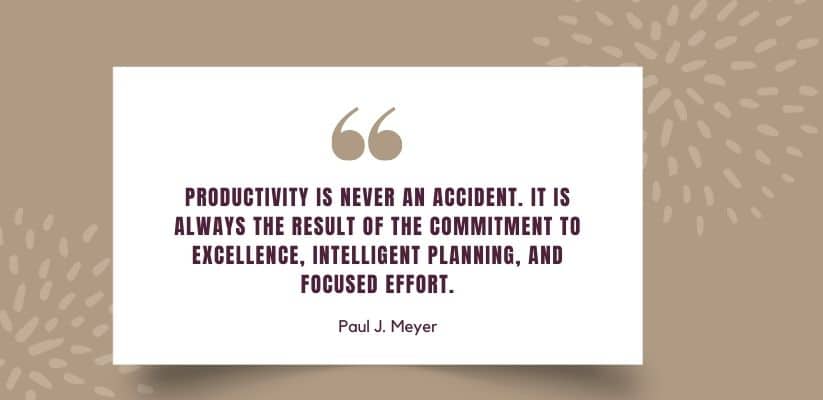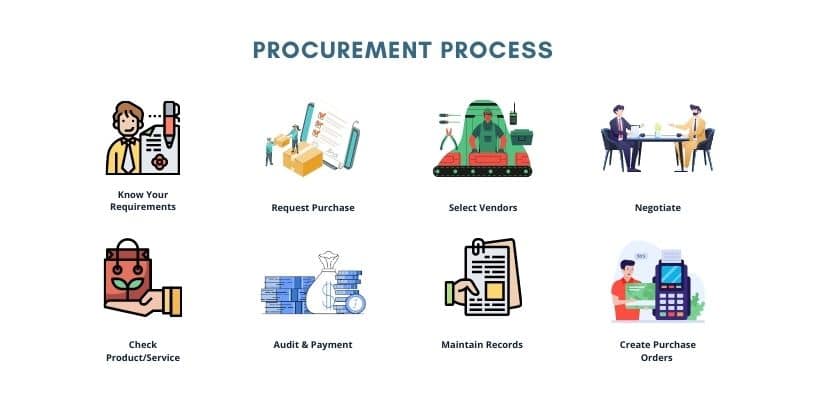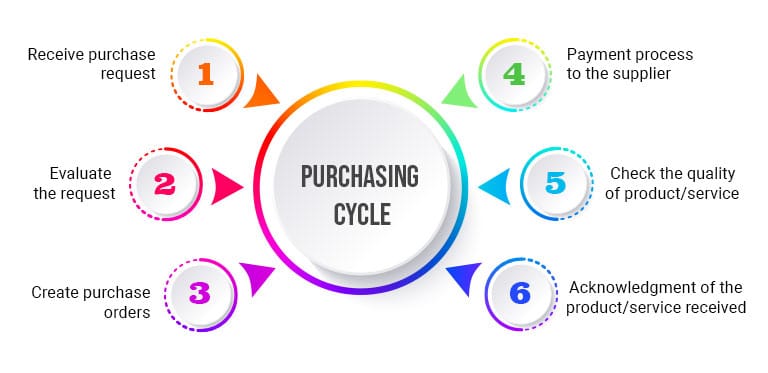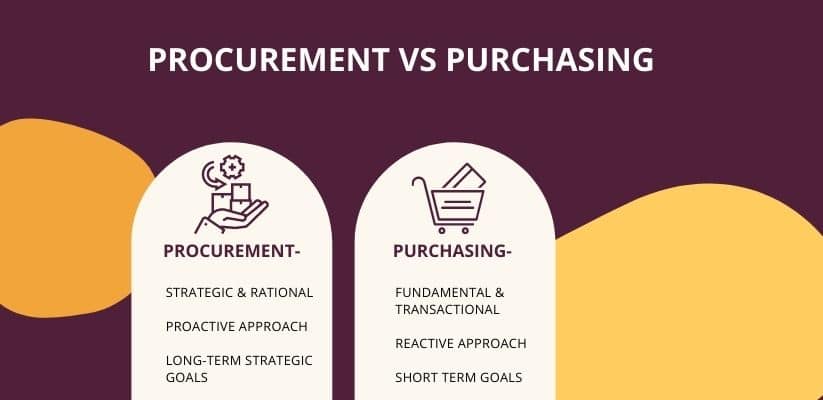Summary: Procurement and purchasing terms are used conversely whenever it comes to getting goods/services for the functioning of your business. But, in reality, the terms are too different from each other and have different objectives, goals, and processes. So, let’s see the difference between procurement and purchasing.

Mostly procurement and purchasing terms are used conversely whenever it comes to getting goods/services for the functioning of your business. But, in reality, the terms are too different from each other and have different objectives, goals, and processes. In business, the strategies used to sell products/services have a great impact on the cost-effectiveness of the objectives. Hence, it is imperative to understand the difference between purchasing and procurement to carry the business functions smoothly while maximizing the values more effectively.
What is a Procurement?
Procurement is the method of purchasing a particular service or a product for commercial purposes or on a large scale to meet business objectives. The primary role of procurement includes identification of business needs, analyzing the market to get a supplier, making the goods and services ready to sell, maintaining transactions, and negotiating with the selected supplier. However, making such transactions might be a tedious job, and owing to this the procurement teams have high value within an organization.
In short terms, the procurement process is all about shortlisting, identifying, selecting, and purchasing goods/services from a vendor (third party). While the purchasing can be carried out through competitive bidding and direct purchase which will assure timely delivery with appropriate quantity and quality.
Let us understand the different steps involved in the procurement process.
<<< Also Read: The Possibilities of Global Procurement for Suppliers through a Single System>>>
Steps Involved In Procurement Process
Step1: Understand your requirements
So, the first step is to understand what you require and then plan how can you achieve it. The step revolves around analyzing the product requirement; be it a fresh item or re-ordering of a service/product. However, the process can be carried out by the procurement manager, departmental head, CEO, or even business owner.
Step 2: Request purchase
In this step, a customer requests a purchase of the product/service to the company usually through e-procurement software. A financial controller or a procurement controller looks after purchase requests. On the approval of the request, a purchase order gets created while if the request gets denied, the person will get a letter mentioning the reasons for request denial.

Step3: Calculate and select vendors
Some organizations have approved vendor portfolios along with a list of suppliers who have successfully cleared the selection criteria and negotiation benchmarks of the purchaser. However, this is the usual case in which the organization already knows where to get the supplies.
So, in this step, once the vendor gets selected organizations focus on building long-term relationships with the vendor to get the desired price, quality while saving a lot of time on predictive procurement functions.
Step 4: Negotiation
Usually, the contract process starts when the vendor has started to meet the business’s requirements. Undoubtedly, contracting is the crucial step that helps achieve maximum value generation while encouraging connection between buyer and supplier.
The process involves an array of entities such as pricing structure, work scope, delivery dates, and terms & conditions, and much more. Moreover, cost reduction processes such as offering discounts can also be embraced via negotiation and contract analysis procedures.
Step 5: Develop purchase orders
Once the negotiation is done, the next step is to develop a purchase order which is nothing but an official document to purchase goods/services. A purchase order has the price of the product/service, features, terms & conditions, and more such details. Once the contract is signed, you can send the purchase order letter to the seller. After successful acceptance of the purchase order from the seller, a legally enforceable contract is generated.
Step 6: Inspect the product/ service & rectify essential factors
The sixth step involves receiving and inspecting the supplied services/ products. Here, the company which has received the service/product is bound to check the product and acknowledge the reception. If the service/product is not up to the mark, the company can simply refuse the delivery in the case it is damaged or missing. It is an important factor to consider the difference between procurement and purchasing.
Also, the step includes checking the basic essential factors known as the 3-way matching process. Through this process, the procurement team will check the 3 pivotal documents and will see if the transaction is accurate. The documents are purchase orders, packaging slips, and vendor invoices. The biggest benefit of carrying out the cross-checking of the document is that it can look for discrepancies that might cost huge for the company. Hence, if any mismatch is observed, it should get resolved instantly.
Step 7: Payment delivery & audit
Usually, a purchase order is attached with an invoice whenever it is delivered to the supplier. The invoice has all the details regarding the price of the product/ service. In the seventh step, the procurement team will cross-check the purchase orders as well as invoices to make sure about the quality and quantity. Then, the payment is released as per the terms and conditions mentioned between the vendor and the purchasing party.
Once the good/service is received and accepted at the organization level, they should conduct an audit to ensure that all quality standards have been satisfied.
Step 8: Keep records
The purchasing company should always keep records for accounting and bookkeeping operations. This indicates that for every complete purchase, the company should save needed paperwork to make further processes seamless.
Now, let us understand about purchasing.
What is Purchasing?
Purchasing is the systematic acquirement of a product/service on behalf of the purchasing element. Purchase functions ensure that the required items are bought within the estimated time and in a cost-effective way. A purchasing department is very crucial in a manufacturing company that buys a huge amount of raw materials on a regular basis.
Let’s have a look at the key objectives of purchasing section-
- Find and select suppliers who can fulfill your product/services specifications
- To buy things that can satisfy the buying quality requirements
- Generate a skilled team of deliveries that lowers down the inventory of raw materials. This assures that commodities are available whenever required.
- Reduce the expense spent on inventory management.
The primary function of a purchasing department is to receive and check purchase orders across the organization. The department should-
- Create and send the qualified supplier requests for proposal documents
- Rectify and accept purchases by sending invoices to vendors
- Monitor contracts having long terms
- Check orders that need to be closed

Steps Involved In Purchasing
To attain maximum efficiency, savings, and time, the purchasing process refers to the thorough framework in order to optimize the purchasing process.
Procure-to-pay process
This P2P process is another term for the purchasing process. In general terms, the purchase process is just like making a transaction. The procurement team may leverage purchasing goods/services through the supply chain to deliver higher levels of experience.
Formal purchase process
The plus point of the formal purchase procedure is that it avoids waste from theft, rogue spending, fraud, and other financial concerns that might be caused due to ineffective purchasing behavior.
If you have a global company or have an SME, having an efficient and streamlined purchasing process is crucial to stay competitive in the current situation. It is because procurement is the core of the value creation process of the organization.
<<< Also Read: Don’t let procurement fraud eat into your profits >>>
5 Factors that Differentiate between Procurement and Purchasing
Factor 1: Planned and strategic
In generic terms, procurement is a strategic function while purchasing is a tactical function. Purchasing revolves around the transactional facet of purchasing products/services that initiate with placing the order and closing with its acceptance.
On the other hand, procurement showcases the whole array of processes right from the moment a product/service requirement is commenced. It deals with strategic points including choosing the appropriate supplier, setting the contractual value of the product/service. In simple terms, procurement is a complete end-to-end procedure that goes on even after the order has been received. Therefore, it is the most crucial part of any manufacturing organization.
Factor 2: Motive and goals
The main objective of purchasing is to focus on minimizing the price of the order while procurement deals with the total cost of ownership and value creation. Also, procurement deals with contract compliance, risk mitigation, the cost-effectiveness of products/services, and more.
Factor 3: Better supplier relationships
Procurement assists suppliers to stay valuable partners of the business. This ensures a healthy relationship from both the supplier and the organization’s end. It also emphasizes more on developing collaborative, long-term, and most chosen suppliers. This ensures to enhance the value of a supplier-business relationship which is one of the critical components of the procurement process.
It is not the case in the purchase.

Factor 4: Risk mitigation & evaluation
Purchasing does not hold the nature of identifying and mitigating risks. But, absence of focus proves to be hazardous to an organization which then converts into various types of supply chain risks such as financial risk, data security risk, and operational risk, and more. In such a case, procurement plays a vital role in identifying risks with business effects. It also mitigates the risk by fostering compliance across all suppliers.
Factor 5: Engagement of human resources
Purchasing involves less number of persons which makes it a very tedious process. While in the procurement, every stage would need a number of persons who would contribute to respective fields of the process. Hence, improvised communication skills, networking, and transparency among stakeholders are quintessential for success.
Wrapping Up
So, by now you must have understood the major difference between procurement and purchasing processes. Despite they are being used interchangeably, they possess huge differences. A deep understanding of these terms assists organizations enhance their performance and productivity.
The procurement process is an end-to-end function that covers the complete process of fulfilling a business’s requirements. With procurement, you can automatically enhance value creation. Conversely, purchasing is a subpart of procurement that looks after the transactional view of acquiring products/services. Also, purchasing deals with placing the order and making the delivery as well as payments on time.
To be more clear, procurement embraces all aspects of strategic functions making sure that cost savings, value for money, and more such factors are identified. Purchasing is a clerical function of just ordering or buying products/services.





